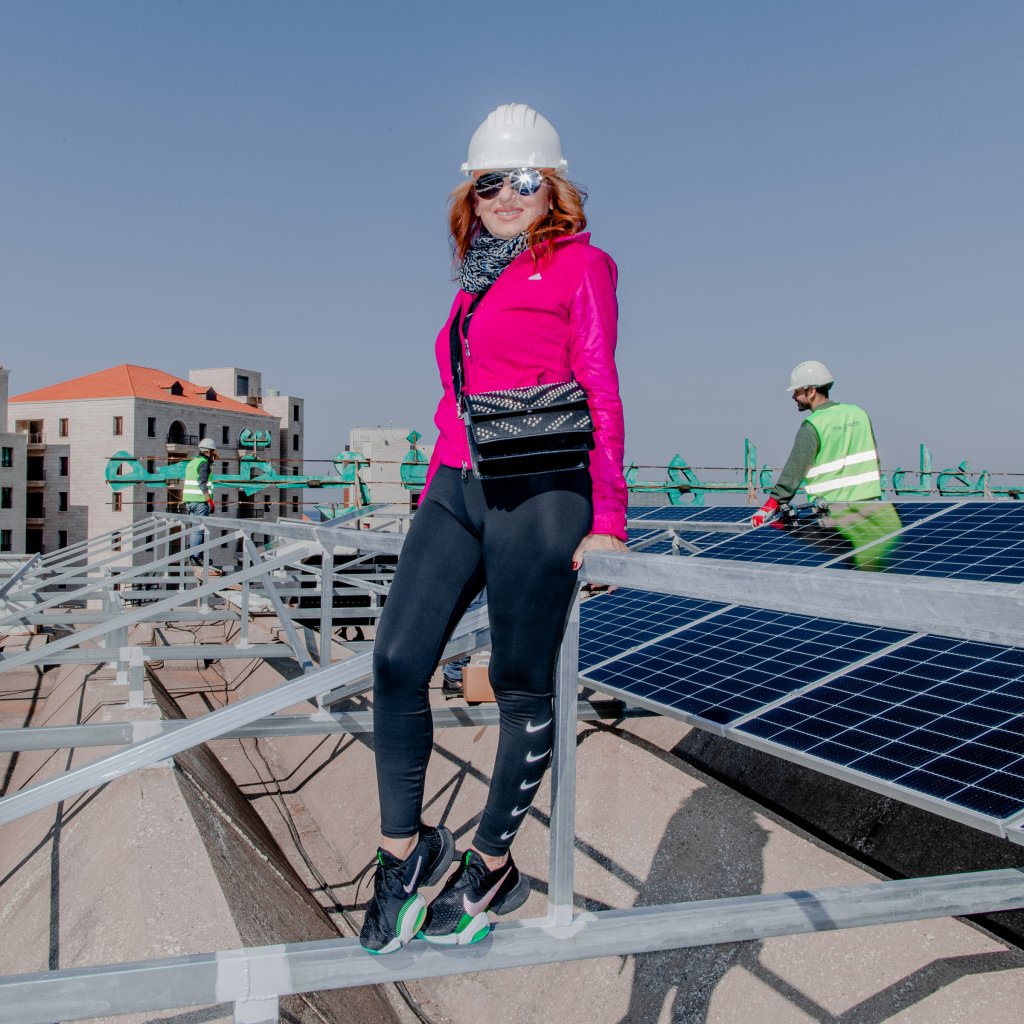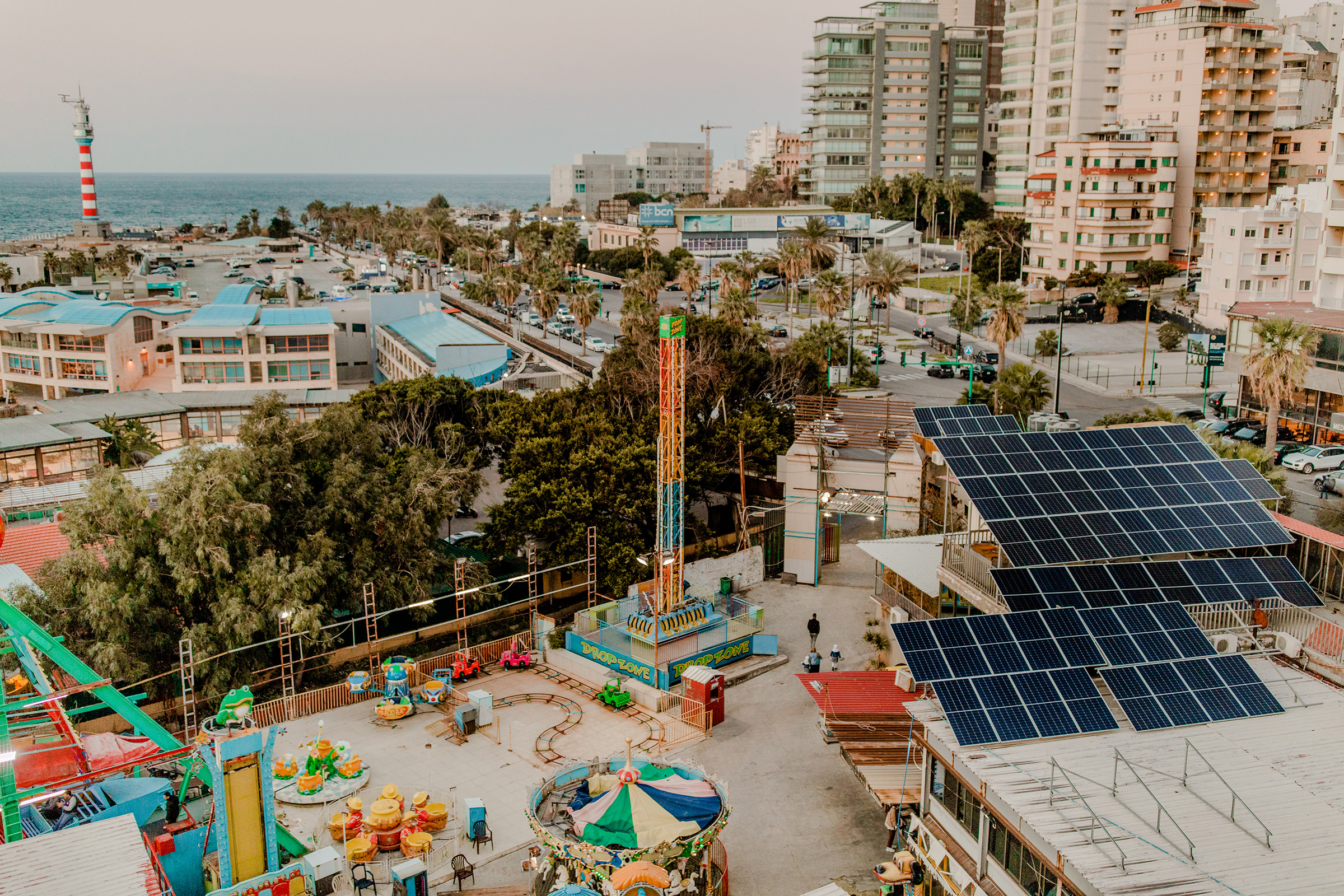About 2,300 ft. above Beirut in the Matn District mountains, Roger Mazloum and his brother Elias greet me on an unusually balmy winter day as they chop wood to help keep their early 20th century home warm before the cold returns. I’m no match for these burlier Lebanese men, who grew up in Broummana, a town of 15,000 people about a dozen miles east of the Lebanese capital, but I politely take my turn, meekly swinging an ax at the tree stump before us. After a lackluster start, and plenty of patience from the pair, something akin to firewood begins to splinter off.
Roger takes me through the family home’s front door—past a living room with traditional Lebanese floor tiles and artwork dedicated to the late Umm Kulthum, the Egyptian titan of Arabic music—and up the stairs to the roof. The pine-covered mountains and a foggy glimpse of the Mediterranean Sea are a pleasant distraction, but the real purpose of the tour is to see the 18 solar panels slightly obscuring the vista. Like tens of thousands of Lebanese people, the Mazloums have turned to solar power to generate reliable—and cost-effective—electricity in a country where the crisis-stricken state provides as little as one or two hours of power a day.

“In the past, even when the situation was normal, we used to have five, six, seven hours of power cuts a day,” Roger says, as the three of us sip Arabic coffee on their balcony. He is referring to the period before an economic crisis began in 2019 that has seen the Lebanese lira lose more than 98% of its value against the U.S. dollar.
The state-run Electricité du Liban (EDL) has a generation capacity of around 1,800 megawatts, according to Pierre Khoury, the director of the government-affiliated Lebanese Center for Energy Conservation (LCEC), compared with the estimated 2,000 to 3,000 megawatts the country needed before the crisis. But EDL provides only around 200 to 250 megawatts today, because the economic collapse means the government struggles to pay for the imported fuel used to power the country’s two main electricity plants.
I lean over while Elias, a civil engineer by training, pulls out his Android phone. As the TBB Nova app he uses to manage the Mazloums’ solar-power system shows, the 18 panels are generating over one kilowatt per hour, enough to power a large home where several generations of Mazloums live. He says that the solar panels and battery system, which were installed in July 2020, are saving the family between $3,000 and $4,000 a year in electricity and generator bills. (They spent over $10,000 to install them.) “But the main thing is reliability,” Elias says. “For the last two years, we basically didn’t have power cuts… Even in the really difficult times we were still up and running.”
The Mazloums are hardly alone in Lebanon. Solar panels have been cropping up across the country over the past two years, from the rooftops of rural households to urban apartments, and from atop family-run businesses to buildings housing national and multinational organizations.

Lebanon went from generating zero solar power in 2010 to having 90 megawatts of solar capacity in 2020. But the major surge happened when a further 100 megawatts were added in 2021 and 500 megawatts in 2022, according to the LCEC’s Khoury. The Lebanese government committed in 2018 to an ambitious target to source 30% of the country’s energy from renewables by 2030 and reaffirmed that pledge at the U.N.’s COP27 climate summit last year. Khoury says that the LCEC believes the target “could be achieved,” with solar power being “one major contributor.”
Atop several campus buildings at Sagesse University in Furn El-Chebbak, a suburb southeast of Beirut, row upon row of solar panels gleam under the bright afternoon sun. The Catholic university, home to some 3,500 students, is one of the many organizations in Lebanon that have turned to solar power. When I visit, Salim Nasr, a project manager at ME Green and electrical engineer by training, is overseeing the last few steps of the installation of around 460 solar panels to cover the university’s needs. “We are talking about 300 kilowatts peak, on a sunny day like this,” Nasr says, which can be used to power everything, including “lights, chillers, ACs, refrigerators, coolers, heaters.”

The team at ME Green, a renewable energy company set up in 2010, has spent four months installing the solar-panel system at Sagesse University. Unlike the Mazloums, the university has opted not to install a battery, to help keep the costs down for such a large-scale project. The campus still relies on generators, but the panels cut their use by around 70%—an enormous financial saving, not to mention the green benefits of not having them spewing as much diesel. “The return on investment is less than one year,” says Abdo Kmeid, founder of A.K. architects, who consulted for the project.
As we make our way downstairs, we’re greeted by Lara Boustany, the president of Sagesse University. She says that the decision to install the solar-power system is part of a wider green initiative on campus. “But we started with solar energy sooner than expected, because of the lack of electricity in Lebanon,” she says. “Actually, both the lack of electricity and the fuel problems in Lebanon. Sometimes we are short of fuel. We are also paying a lot for fuel.”
ME Green was one of the early solar-power companies in Lebanon, but the sector has ballooned, from around 150 registered businesses in 2020 to more than 800 today, according to the LCEC’s Khoury. These companies work on everything from small household systems—which start at $2,000 to $3,500—to projects involving hundreds of panels or more.


“We wanted to start in Lebanon because you have an energy problem, and you have renewable energy resources, with more than 300 days of sunshine,” says Philippe El Khoury, CEO and co-founder of ME Green, which has offices in Lebanon and Belgium. Yet he, and others quoted in this story, have mixed feelings about the solar-power boom. On the one hand, they say, it has undeniable environmental benefits. On the other hand, EDL’s failure to provide electricity, coupled with a lack of large-scale solar farms and green infrastructure, means that overall Lebanon still relies more on heavily polluting generators. “The amount of CO2 you are reducing from using solar panels, you are also turning on diesel generators for longer,” says Marc Ayoub, an energy expert at the American University of Beirut.
For this reason, Ayoub says, the real green solution needs to come at “the community level—villages, municipalities, regions. This is where you start having a big environmental impact.”
But these kinds of projects need a level of investment that Lebanon’s cash-strapped government can’t deliver. Foreign lenders could step in but experts say most are reluctant until the country finalizes a deal with the International Monetary Fund; talks over a $3 billion loan contingent on reforms have been sluggish.

In the meantime, ME Green and other small companies are continuing to encourage solar power in Lebanon. El Khoury, the ME Green executive, sees every installation that his company completes as a victory against diesel-spewing generators. “Every time I kill a generator, I’m very happy. This is my mission: kill the generator,” he says.
That goal of encouraging renewable energy in Lebanon has been aided by the fact that solar power is now the most affordable way to generate electricity around the world. The cost has dropped by more than 90% over the past decade, thanks to rapid technology gains and a glut in solar-panel production.
Back at the Mazloums’ balcony, as we have our last sips of coffee, Elias is touting solar power in ways that would thrill not just El Khoury but renewable advocates everywhere. He says they hardly use generators anymore because “one, the sound; two, the maintenance; and three, you know, you have to get the”—Roger interjects, “diesel is expensive”—“it’s not as efficient and reliable as the solar system.”
As Elias points out, it’s a conclusion many in Lebanon have come around to, regardless of the environmental considerations. “People are seeing the real benefits,” he says. “Look, at the end of the day, we are becoming green without even noticing it.”
More Must-Reads From TIME
- The 100 Most Influential People of 2024
- The Revolution of Yulia Navalnaya
- 6 Compliments That Land Every Time
- What's the Deal With the Bitcoin Halving?
- If You're Dating Right Now , You're Brave: Column
- The AI That Could Heal a Divided Internet
- Fallout Is a Brilliant Model for the Future of Video Game Adaptations
- Want Weekly Recs on What to Watch, Read, and More? Sign Up for Worth Your Time
Write to Adam Rasmi/Beirut, Lebanon at adam.rasmi@time.com
